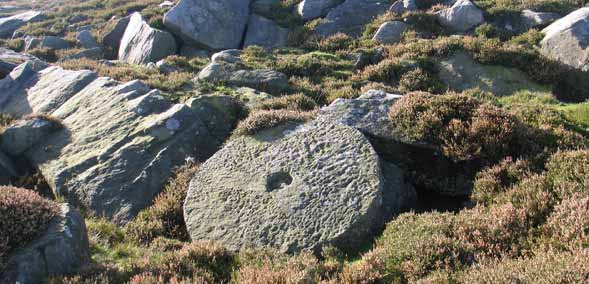Corn milling
Ordnance Survey maps from the 1850s show many corn mills within the Yorkshire Dales. Wheat was cultivated within the Dales at various points but by the mid-nineteenth century, corn mills would have milled grain imported from outside the Dales. Millstones were obviously an essential piece of equipment in corn milling: it took time and skill to extract, transport and finish them. By the later nineteenth century most corn mills had been converted to other industrial uses such as flax or saw mills.
Making millstones
Millstone making originated in the medieval period, possibly earlier, and continued into the twentieth century in some parts of the country.
One of the best and most common stone used for millstones is millstone grit. It is found widely throughout the Pennines. It occurs in the north and south east of the National Park and in smaller outcroppings on the higher ground throughout the area.
Millstones and grindstones
Millstone grit has also been exploited for gateposts, mullions, lintels and other key pieces of building stone. Hollowed out blocks of millstone grit were often used as stone troughs. Millstone grit can also create 'grindstones' for other industrial processes. Grindstones tend to look very much like millstones. We don't know how much this was happening in the Yorkshire Dales and more information on the types of 'millstone' that appear in the National Park might help us to better understand what was going on.
How to make a millstone
Stone used for the creation of millstones had to be free of natural lines of weakness that might cause it to crack whilst being quarried, or later under the stress of operation in the mill. In order to extract millstones from surface outcrops of millstone grit, a shallow circular channel that outlined the millstone was cut. Further slots were cut into the channel and these were filled with wooden wedges.
Once in place, the wedges were soaked with water so that they expanded and caused the stone to split, so allowing for its extraction as a single piece. The central holes in the stones were cut on site. This extraction method leaves circular cavities in the millstone grit, or sometimes just the shallow circular channel if the stone was found to be flawed before it was complete.
Stones frequently cracked during quarrying or whilst the central hole was being cut and incomplete stones can often be found around millstone quarries. Place names can give us an obvious pointer in the hunt for those quarries - the name ‘Millstone’ appears at numerous scars and boulder fields on the higher ground of the Yorkshire Dales.
Moving millstones
There are two suggested methods for the moving of millstones from quarries. The first is by horse-drawn sled and the second, which has been documented in other parts of the country, is where pairs of millstones were joined by an axle and carefully rolled away from the quarry site. It's likely stones will have broken on route as well as during construction.
Millstones are found in or around former corn mills but may also be visible where they have been cut up and reused as construction material for later buildings, for example, quoin stones. Others are found as unfinished or broken stones on the hillside. Some have been more recently re-used as garden ornaments and decoration or even as village signs, for example in Askrigg.







